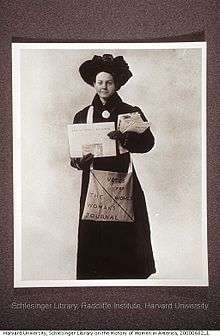Florence Luscomb

Florence Hope Luscomb (1887–1985) was an American architect and women's suffrage activist in Massachusetts. One of the first women to graduate from the Massachusetts Institute of Technology with a degree in architecture, Luscomb became a partner in an early woman-owned architecture firm before work in the field became scarce during World War I. She then dedicated herself fully to activism in the women's suffrage movement, becoming a prominent leader of Massachusetts suffragists.
Biography
Luscomb was born in Lowell, Massachusetts, the daughter of a dedicated suffragist and women's right activist. Soon after her birth, her parents separated and she moved with her mother to Boston. As a child in Boston, she went with her mother to women's suffrage events, at one point seeing Susan B. Anthony speak. She became an ardent suffragist, starting by selling a pro-suffrage newspaper on the street.[1]
Luscomb was among the first women to earn a degree in architecture from the Massachusetts Institute of Technology.[2] Women still experienced significant challenges during her tenure there. For example, Luscomb had to inquire at twelve firms before one of them would hire her for an internship after her second year. Following her graduation, she was hired by Ida Annah Ryan, the first woman to earn an architecture degree from M.I.T.[2] She would later become a partner in Ryan's firm.[1] Ryan and Luscomb shared an interest in women's suffrage, and Ryan gave Luscomb a degree of flexibility at work that allowed her to be active in the women's suffrage movement.[2] During this time, Luscomb helped organized various events for the suffrage movement, and during a debate on adding a suffrage amendment to the state constitution gave more than 200 speeches in 14 weeks.[1]
She later continued her education in architecture at the newly opened Cambridge School of Architecture and Landscape Architecture in 1916, and began working with local architect Henry Atherton Frost and landscape architect Bremer Whidden Pond in addition to her work with Ryan. However, her career was put on hiatus when new construction slumped due to the entrance of the United States into World War I.[1][2] As a result, she accepted a position as Executive Secretary for the Boston Equal Suffrage Association for Good Government.[1] She would go on to work for a number of organizations in the Boston area, including the Boston chapters of the League of Women Voters and the Women's International League for Peace and Freedom and organizations dedicated to prison reform and factory safety. Luscomb also helped found a local of the United Office and Professional Workers of America and served as a volunteer with the local NAACP and ACLU.[1]
Upon her mother's death in 1933, Luscomb inherited enough money that she could dedicate her time fully to activism. She would run for public office four times. The first, for Boston Council in 1922, she nearly won. Races for Congress in 1936 and 1950 and for Governor in 1952 were largely protest campaigns. An ardent anti-McCarthyist, she was at one point called to testify before a committee in the Massachusetts legislature that was investigating communism. She wrote an early anti-Vietnam War leaflet and would later advise some of the founders of the American feminist movement, encouraging them to include the poor and women of color. In her later life, she took up residence in a Cambridge cooperative house at 64 Wendell Street where she lived until shortly before her death in a Boston elder-care facility in 1985.[1]
She is commemorated on the Boston Women's Heritage Trail.[3]
External links
- Papers, 1856-1987. Schlesinger Library, Radcliffe Institute, Harvard University.